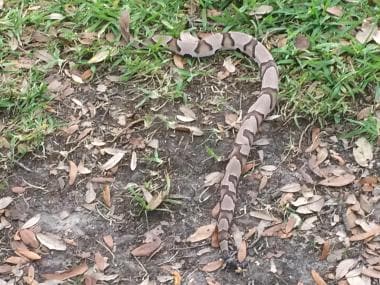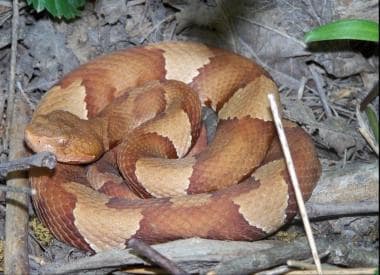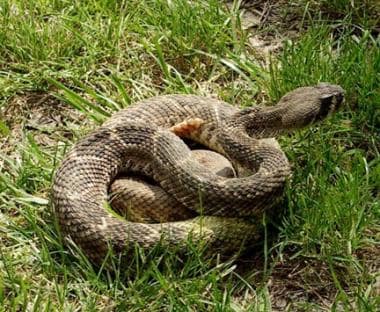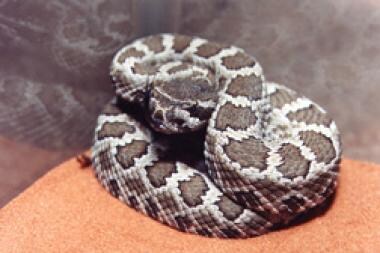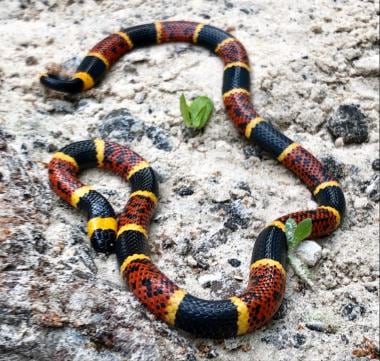Background
The World Health Organization (WHO) estimates there are up to 1.8 million bites from venomous snakes annually worldwide, causing 20,000-90,000 deaths. [1] The vast majority of venomous snake species are viperids (eg, rattlesnakes, Gaboon vipers) or elapids (eg, cobras, taipans). Although most snakes in the Colubridae family are nonvenomous, some (eg, boomslang) are venomous and responsible for significant morbidity and mortality.
In the United States, several thousand snakebites occur every year, resulting in fewer than 10 deaths. [2, 3, 4, 5] There are four types of venomous snakes native to the United States: copperheads, cottonmouths (water moccasins), rattlesnakes, and coral snakes. The first three are crotalids in the family Viperidae, subfamily Crotalinae. There are approximately 25 species of rattlesnakes in the genera Crotalus and Sistrurus. The genus Agkistrodon has both copperheads (Agkistrodoncontortrix, Agkistrodonlaticinctus) and cottonmouths (Agkistrodonpiscivorus, Agkistrodonconanti). Collectively, these crotalids, also known as pit vipers, account for greater than 95% of all native snake envenomations.
Coral snakes are the only elapids that are native to the Western hemisphere, and the three species of US coral snakes account for less than 5% of all native envenomations.
Crotalids are characterized by large, triangular heads, comparatively small eyes, large and retractable fangs, and a thermoreceptor “pit” located between the eye and the nostril. Pit vipers also have a single row of subcaudal plates distal to the anus, and rattlesnakes have one or more keratin buttons that compose the “rattle” at the distal end. Although some references recommend using the pupil shape as a way of distinguishing a pit vipers from noncrotalids, it should be noted that all snakes can have round or elliptical pupils, depending on the amount of ambient light. Additionally, many nonvenomous snakes can flatten their heads into a triangle shape when they feel threatened. Experts recommend that people learn to recognize the venomous species in their vicinity rather than rely on mnemonics.
See the images below.
There are three species of coral snakes in the United States. The Sonoran coral snake, Micruroides euryxanthus euryxanthus, is found in Arizona and western New Mexico. The Texas coral snake, Micrurus tener, is found in Texas, Louisiana, and Arkansas. The Eastern coral snake, Micrurus fulvius, is confined to the Southeastern United States as far north as North Carolina and as far west as Mississippi. The rhyme "red on yellow, kill a fellow; red on black, venom lack" is commonly used to distinguish coral snakes from nonvenomous species, but there are many exceptions. Some native coral snakes have aberrant patterns that do not adhere to the rule, and nonnative coral snakes may have completely different coloration. Conversely, there are nonvenomous snakes such as the shovel-nosed snakes (genus Chionactis) in which "red touches yellow". It is best to look at a combination of features, including head shape, body habitus, and coloration, to make a snake identification. When in doubt, it is prudent to assume a snake is venomous and leave it alone.
See the images below.
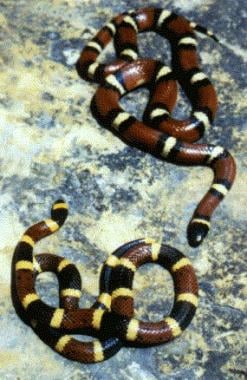 Comparison of the harmless Mexican milksnake, Lampropeltis triangulum annulata (top) with the Texas coral snake, Micrurus tener (bottom). Courtesy of Charles Alfaro.
Comparison of the harmless Mexican milksnake, Lampropeltis triangulum annulata (top) with the Texas coral snake, Micrurus tener (bottom). Courtesy of Charles Alfaro.
A large number of exotic species are kept by both zoos and private collectors, making bites by nonindigenous species increasingly common. A full review of these snakes is not possible here.
Pathophysiology
Crotalid venom is produced and stored in paired glands below the eyes. Crotalids have hollow, mobile, relatively long fangs located in the front of the upper jaw and are capable of delivering venom quite efficiently. Less than 10% of crotalid bites are “dry”, meaning there is no venom deposition. A number of factors determine how much venom is delivered, including the species, age, size, and overall health of the snake, as well as its diet and the last time it had fed or released venom.
Coral snakes have shorter, fixed, front fangs and a smaller mouth, which make them deliver venom less efficiently. In the wild, snakes often hang onto their prey until the venom takes effect. However, despite the persistent myth, coral snakes do not need to "chew" in order to envenomate. It is estimated that 30% or more of coral snake bites are dry.
Snake venom has been described as a "soup of antigens" and comprises a variety of protein and nonprotein substances. Most crotalid venom contains a mixture of metalloproteinases, collagenase, phospholipase, and hyaluronidase that can cause myonecrosis and dermatonecrosis. [6] Multiple venom components, such as serine proteases, disintegrins, metalloproteinases, and C-type lectinlike proteins, produce a variety of hematologic effects, resulting in coagulopathy, platelet aggregation, platelet activation or platelet inhibition, or increased coagulation, leading to thrombotic complications [7]
Certain crotalid species have unique toxins. Crotalocytin, found in the Timber rattlesnake (Crotalus horridus), causes platelet aggregation. [8] Mojave toxin, found in some populations of the Mojave rattlesnake (Crotalus scutulatus), inhibits the presynaptic release of acetylcholine, leading to weakness and paralysis. [9] Pit viper venom may also include bradykinin-related peptides that can lead to angioedema and hypotension. [10]
Coral snake venoms are complex mixtures that include phospholipase A2, multiple proteases, high–molecular-weight protein, and a variety of neurotoxins. Approximately 380 isoforms of phospholipase A2 have been identified in snake venoms, and their effects include neuromuscular paralysis, bleeding, myonecrosis, edema, widespread inflammation, and platelet aggregation. [11, 12] In coral snakes, the neuromuscular effects are most pronounced.
There are several other neurotoxins found in coral snake species. Most are alpha-toxins, which competitively antagonize postsynaptic acetylcholine receptors on the neuromuscular junction. Weakness and paralysis result, although these can be overcome by increasing local acetylcholine concentrations. Myotoxic and edematogenic effects have also been detected in several coral snake venoms, with particularly strong activity the Eastern coral snake Mfulvius. [13] Coral snake venom components can also activate the classic complement pathway and subsequently generate anaphylatoxins, which contribute to vasodilation and allow for greater distribution of other venom components. [14]
Etiology
Previous studies suggest that most people get envenomated because they are intentionally interacting with the snake. [15] Data from the North American Snakebite Registry (NASBR), which is administered by the American College of Medical Toxicology, Toxicology Investigator’s Consortium (ToxIC), demonstrated that only 19% of bites between 2013 and 2015 were the result of intentional interaction. [16] Males accounted for 91% of these victims, and 100% of bites that resulted from intentional interaction involved the upper extremity.
There is no doubt that antagonizing a venomous snake increases an individual's likelihood of being envenomated, but most bites affected victims who were unaware of the snake's presence prior to being bitten.
However, many bites can be prevented if people would avoid intentionally interacting with venomous snakes whenever possible.
Epidemiology
Frequency
United States
Snakebites, especially from nonvenomous snakes, frequently go unreported. Approximately 10,000 bites are reported in the United States annually, particularly in Texas, Florida, California, Arizona, North Carolina, and Georgia. Mortality from snakebites is rare, with 2-10 deadly snakebites annually.
International
Snakebites also go unreported in the developing world. An estimated 1.8 million venomous snakebites occur worldwide each year, resulting in an estimated 20,000-90,000 annual deaths. [1] Worldwide, snakebites disproportionately affect low socioeconomic populations in more rural locations. They often occur as bites to the lower extremities by farmers or workers who step on or disturb a snake in the field or rice paddies, or they can present as a bite to the head or trunk in individuals sleeping outside on the ground.
Race
Of US victims of snakebites in one study, 84.5% were white. [16]
Sex
According to NASBR data, 69.3% of victims are male and 30.7% of victims are female. In males, 45.2% of bites affected the lower extremity and 54.8% of bites involved the upper extremity. Conversely, 77.5% of bites in women were to the lower extremity and only 22.5% affected the upper extremity. [16]
Age
Children younger than 13 years old accounted for 1,286 (10.6%) of the 12,111 snakebites reported to the American Association of Poison Control Centers between 2015 and 2017. Children age 12 and younger comprised 28.2% of snakebite patients recorded in the NASBR between 2013 and 2015. [16] Most (69.5%) bites in children involved the lower extremity.
Role of drugs and alcohol
It is a common misconception that most snakebite victims are under the influence of intoxicating substances when they are envenomated. In a study of snakebite reports to the American Association of Poison Control Centers, only 608 (0.7%) of 92,751 snakebites were associated with concomitant drug or alcohol use. [17] However, those who used alcohol were 27 times as likely to receive antivenom and 31 times as likely to die from the envenomation compared to those who had not consumed ethanol.
Seasonal variation
Although snakebites do occur throughout the year, they are most common in the summer months, from June to September.
Prognosis
Death is rare. Most patients recover fully, although many patients, particularly those who are not treated or are undertreated, may have prolonged or even permanent disability.
Mortality/morbidity
A 20-year review of data from the National Vital Statistics Systems identified 97 fatalities. The state of Texas had the most fatalities (17), followed by Florida (14), and Georgia (12).
Most snakebite victims survive, even without antivenom. However, death may result from intravenous deposition of venom, anaphylaxis, nonimmune anaphylactoid reactions, and following systemic toxicity (eg, cardiovascular collapse, respiratory failure.)
Bites that go untreated or are undertreated may result in prolonged or even permanent disability. Timely administration of antivenom can accelerate recovery and reduce the likelihood of long-term deficits.
Patient Education
Prevention is key in limiting morbidity and mortality from snakebites. People who live in snake-endemic areas and those who engage in high-risk activities should be advised to wear proper attire and footwear and to not place a hand or foot in a bush or other unseen area.
If someone is bitten, he or she should seek medical attention immediately. Victims should call emergency services (911) rather than attempt to drive themselves to the hospital. Many first-aid techniques that were once recommended for snakebites have since proven to be ineffective at best and dangerous at worst. Tourniquets, constriction bandages, pressure immobilization, electric "stun guns", and venom extractors may cause significant harm and should be avoided.
-
Eastern copperhead, Agkistrodon contortrix. Courtesy of Spencer Greene, MD.
-
Broad-banded copperhead, Agkistrodon laticinctus. Courtesy of Kimberly Wyatt.
-
Western cottonmouth, Agkistrodon piscivorus leucostoma. Courtesy of Kimberly Wyatt.
-
Western diamondback rattlesnake, Crotalus atrox.
-
Texas coral snake, Micrurus tener. Courtesy of Chip St. John.
-
Comparison of the harmless Mexican milksnake, Lampropeltis triangulum annulata (top) with the Texas coral snake, Micrurus tener (bottom). Courtesy of Charles Alfaro.
-
Aberrant Texas coral snake, Micrurus tener. Courtesy of Reece Hammock.
-
Juvenile southern Pacific rattlesnake, Crotalus oreganus helleri. Courtesy of Sean Bush, MD.
-
Copperhead bite day 3; initial wounds were to finger.
-
Moderate rattlesnake envenomation in a toddler after treatment with antivenom. Courtesy of Sean Bush, MD.
-
Hemorrhagic bleb following Eastern copperhead (Agkistrodon contortrix) envenomation. Courtesy of Spencer Greene, MD.
-
Proper elevation of upper extremity bite. Courtesy of Spencer Greene, MD.
-
Swelling and bruising after crotalid envenomation. Courtesy of Spencer Greene, MD.
-
Copperhead bite day 3; initial wounds were to finger.
-
Copperhead bite day 3; initial wounds were to finger.
-
Superficial necrosis following copperhead envenomation. Courtesy of Spencer Greene, MD.
-
Petechiae 1 week after being treated for black-tailed rattlesnake (Crotalus molossus) envenomation; platelet count = 2,000 (reference range 150,000-450,000). Courtesy of Daniel Jarvis.

